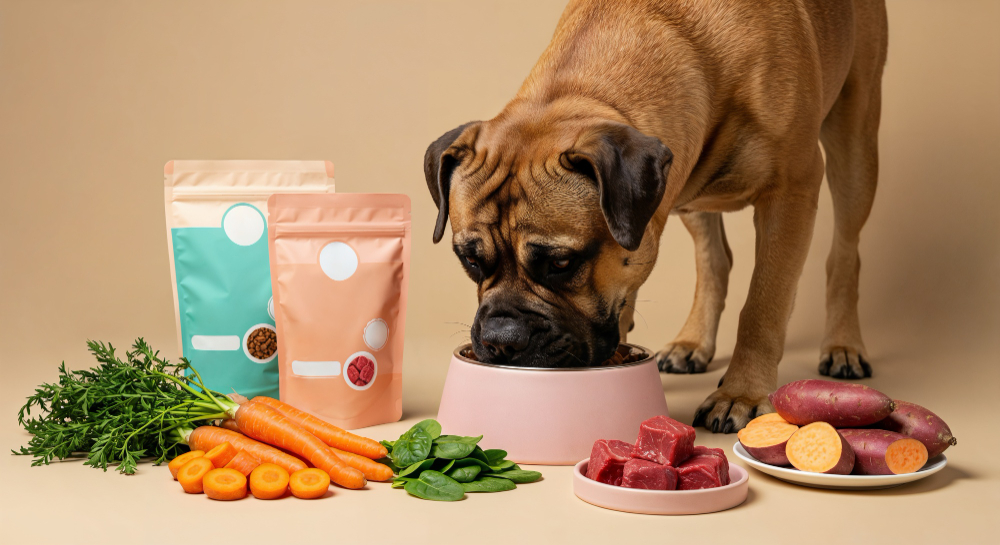
Is Raw Dog Food Good or Bad? [Vet Insights]
As pet parents, we all want what’s best for our dogs — and diet is one of the most debated topics out there. One question I get asked a lot is: “Is raw dog food good or bad?”
I’m Jessica Morgan, a pet care expert at TailWaves.com, and in this guide, I’ll break down the pros, cons, vet opinions, and real-world results of raw feeding. Whether you’re curious, cautious, or already halfway there, this post will help you make a well-informed decision.
What Is Raw Dog Food Exactly?
Raw dog food typically includes raw meat (like chicken, beef, or turkey), bones, organs (like liver and kidney), vegetables, and sometimes fruits or supplements. It’s often called the “BARF” diet — Biologically Appropriate Raw Food or Bones and Raw Food.
The idea is to replicate what a dog might eat in the wild — less processing, fewer fillers, more nutrients.
✅ Benefits of Raw Dog Food
Switching to a raw diet can offer several potential health perks for your pup, especially when done right and under veterinary guidance:
✨ Shinier Coats: Many dog parents report silkier fur, deeper color, and significantly less shedding.
💩 Healthier Poop: Smaller, firmer, and less smelly stools are common—often a sign of better digestion and nutrient absorption.
🦷 Dental Health: Chewing raw meaty bones may help reduce tartar buildup and keep gums healthier—though not a replacement for brushing.
⚡ Increased Energy: Especially noticeable in active breeds, raw diets may support stamina and vitality due to clean protein and fat sources.
🌿 Fewer Allergies: Dogs with food sensitivities to grains, fillers, or artificial additives in kibble may improve on a raw, limited-ingredient plan.
🧼 Improved Breath and Skin: Some owners notice fresher breath, reduced itching, and fewer hot spots thanks to anti-inflammatory nutrients like omega-3s.
⚖️ Weight Management: Raw diets, when properly portioned, can help overweight dogs slim down or underweight dogs bulk up healthily.
🦴 Joint Support: Raw feeding often includes cartilage and bone marrow, which may aid joint function in older or active dogs.
⚠️ Risks and Drawbacks
While raw diets have passionate supporters, they also come with serious risks—especially if not handled or formulated properly:
1. Bacterial Contamination
Raw meat can carry harmful bacteria like Salmonella, E. coli, and Listeria, which can infect both pets and humans. Immunocompromised dogs, children, and seniors in the home are especially at risk. Even freeze-dried raw isn’t always sterile.
2. Nutritional Imbalances
DIY raw feeders often unintentionally miss key nutrients like calcium, phosphorus, or essential fatty acids. An unbalanced diet over time can lead to bone deformities, organ damage, or poor growth in puppies.
3. Choking or Blockages
Whole bones, while good for teeth, can splinter or become lodged in the throat or intestines, causing serious medical emergencies. Always supervise chewing and avoid cooked bones.
4. Cost & Time
Preparing and storing raw food requires freezer space, careful handling, and time for prep—plus, it can cost significantly more than kibble or gently cooked diets.
5. Vet Disapproval or Limited Support
Many conventional vets are cautious about raw feeding due to the risks and lack of regulation. It may be harder to find veterinary nutritionists who will support or help formulate a raw plan.
👩⚕️ What Do Vets Really Think?
Veterinarians are cautious about raw feeding. According to the American Veterinary Medical Association, raw diets pose health risks due to pathogens.
However, some holistic vets support raw feeding when it’s done responsibly and under guidance. The key is balance, quality sourcing, and safety.
In the next part, we’ll explore how to safely transition, vet-approved brands, and compare raw to kibble or gently cooked meals…
Transitioning to Raw, Vet-Recommended Brands & Honest Comparisons
✅ How to Transition to Raw Dog Food Safely
- Start Gradually: Mix 10–25% raw food with your dog’s current diet. Increase over 7–10 days.
- Monitor Reactions: Watch for diarrhea, vomiting, or behavioral changes.
- Use One Protein: Stick with one (like chicken) for the first 1–2 weeks.
- Sanitize Everything: Wash bowls, surfaces, and hands after every meal prep.
🥩 Trusted Raw Dog Food Brands (U.S. Based)
- Stella & Chewy’s: Freeze-dried raw, great for beginners. Clean, balanced, easy to serve.
- Primal Pet Foods: Variety of proteins, includes organic veggies and supplements.
- Instinct Raw (Nature’s Variety): Nuggets or patties, with balanced nutrition and grains optional.
💡 Raw vs. Kibble vs. Cooked: What’s Best?
| Type | Pros | Cons |
|---|---|---|
| Raw | Natural, low-carb, fresh nutrients | Risk of pathogens, costly |
| Kibble | Convenient, affordable, long shelf-life | May contain fillers, less digestible |
| Cooked | Safer than raw, more digestible | Needs refrigeration, premium cost |
Final Thoughts from Jessica at TailWaves
Raw feeding can be rewarding when done right. I’ve seen dogs bounce back from allergies and low energy after switching. But it’s not for every pet or every owner. Choose what fits your lifestyle and your dog’s individual needs.
“It’s not about being trendy — it’s about what works best for your dog’s body, your lifestyle, and your peace of mind.”
Whether you pick raw, cooked, or high-quality kibble, always prioritize nutritional balance and safety. Consult with your vet before switching, and explore reputable products available through TailWaves.
Related FAQs
Is raw dog food safe long-term?
If balanced and stored properly, yes — but always monitor your pet’s health and consult a vet regularly.
Can puppies eat raw food?
Only under vet guidance. Growing puppies need precise nutrient ratios.
What’s the cheapest way to feed raw?
Homemade in bulk is cheapest, but risky without vet-approved recipes. Freeze-dried toppers are a good compromise.
📚 For more expert tips, visit TailWaves Blog.




